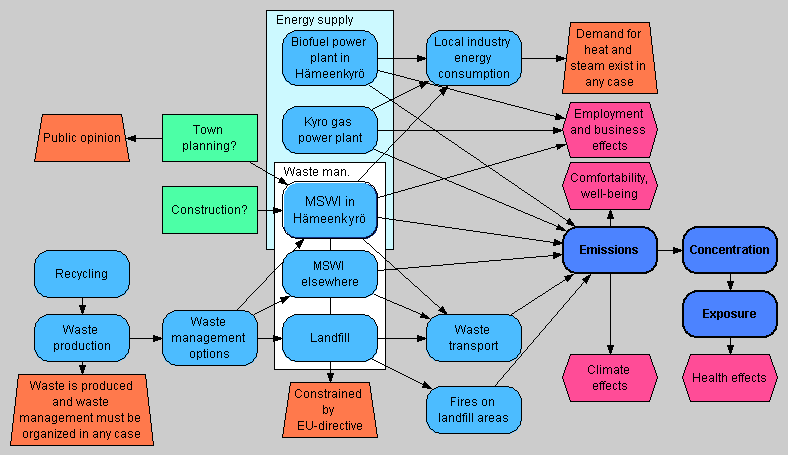Risk assessment on Hämeenkyrö municipal solid waste incinerator: Difference between revisions
Jump to navigation
Jump to search
| Line 304: | Line 304: | ||
|Name = Health effects | |Name = Health effects | ||
|Focus = effects of dioxins and PM<sub>2.5</sub> on human health | |Focus = effects of dioxins and PM<sub>2.5</sub> on human health | ||
|Scope = | |Scope = potential short-term and long-term health effects among Hämeenkyrö inhabitants caused by dioxins and PM<sub>2.5</sub> originating from the Hämeenkyrö municipal solid waste incinerator | ||
|Description = | |Description = | ||
'''Dioxins''' are a group of polychlorinated dibenzo-''p''-dioxins (PCDDs) and dibenzofurans (PCDFs). 2,3,7,8-tetrachlorodibenzo-''p''-dioxin (TCDD) is the most toxic PCDD/Fs congener, and it is classified as a known human carcinogen by the International Agency for Research on Cancer (IARC). | '''Dioxins''' are a group of polychlorinated dibenzo-''p''-dioxins (PCDDs) and dibenzofurans (PCDFs). 2,3,7,8-tetrachlorodibenzo-''p''-dioxin (TCDD) is the most toxic PCDD/Fs congener, and it is classified as a known human carcinogen by the International Agency for Research on Cancer (IARC). | ||
| Line 315: | Line 315: | ||
**impairment of the endocrine system | **impairment of the endocrine system | ||
**impairment of reproductive functions | **impairment of reproductive functions | ||
**increased cancer risk (evidence from animal studies) | **increased cancer risk (evidence from animal studies, weak carcinogens in humans) | ||
Sensitive subgroups: foetuses, newborns, individuals with high fish consumption, individuals working in incineration plants etc. | |||
'''PM<sub>2.5</sub>''' are fine particles less than 2.5 μm in diameter. | '''PM<sub>2.5</sub>''' are fine particles less than 2.5 μm in diameter. | ||
| Line 325: | Line 325: | ||
**increased number of hospital admissions | **increased number of hospital admissions | ||
**increased mortality | **increased mortality | ||
*Health effects related to '''long-term exposure''' | *Health effects related to '''long-term exposure''' (more relevance to public health) | ||
**increased incidence of respiratory symptoms | **increased incidence of respiratory symptoms | ||
**reduction in lung function | **reduction in lung function | ||
| Line 333: | Line 333: | ||
***increased lung cancer mortality | ***increased lung cancer mortality | ||
Sensitive subgroups: children, the elderly, individuals with heart and lung disease, individuals who are active outdoors | |||
|Inputs = | |Inputs = | ||
|Index = | |Index = | ||
| Line 341: | Line 339: | ||
|Unit = | |Unit = | ||
|Result = | |Result = | ||
Dioxins: tolerable daily intake (TDI) | Dioxins | ||
PM<sub>2.5</sub> | *effective dose resulting in a 0.01 increase in lifetime risk of cancer mortality (ED<sub>01</sub>): 45 pg/kg body weight | ||
|References = Health aspects of air pollution. Results from the WHO project "Systematic review of health aspects of air pollution in Europe". World Health Organization, 2004. http://www.euro.who.int/document/E83080.pdf | *tolerable daily intake (TDI): 1-4 pg/kg body weight | ||
PM<sub>2.5</sub> | |||
*6% change in mortality hazards (95% CI 2-11%) per each 10 µg/m<sup>3</sup> elevation in PM<sub>2.5</sub> air pollution | |||
|References = Crump et al. 2003. Meta-analysis of dioxin-cancer dose-response for three occupational cohorts. Environmental Health Perspectives 111 (5), 681-687. | |||
Health aspects of air pollution. Results from the WHO project "Systematic review of health aspects of air pollution in Europe". World Health Organization, 2004. http://www.euro.who.int/document/E83080.pdf | |||
Pope et al. 2002. Lung cancer, cardiopulmonary mortality, and long-term exposure to fine particulate air pollution. JAMA 287 (9), 1132-1141. | Pope et al. 2002. Lung cancer, cardiopulmonary mortality, and long-term exposure to fine particulate air pollution. JAMA 287 (9), 1132-1141. | ||
Service Contract for Carrying out Cost-Benefit Analysis of Air Quality Related Issues, in particular in the Clean Air for Europe (CAFE) Programme. Volume 2: Health Impact Assessment. AEA Technology Environment, 2005. http://ec.europa.eu/environment/air/cafe/pdf/cba_methodology_vol2.pdf | Service Contract for Carrying out Cost-Benefit Analysis of Air Quality Related Issues, in particular in the Clean Air for Europe (CAFE) Programme. Volume 2: Health Impact Assessment. AEA Technology Environment, 2005. http://ec.europa.eu/environment/air/cafe/pdf/cba_methodology_vol2.pdf | ||
Tuomisto et al. 1999. Synopsis on dioxins and PCBs. Publications of the National Public Health Institute B17/1999. | |||
}} | }} | ||
Revision as of 15:35, 20 September 2006
Risk assessment on Hämeenkyrö municipal solid waste incinerator contains a structured risk assessment of a plan to build a MSWI in Hämeenkyrö. There will be a public vote related to a city planning decision: whether the municipality should plan an area for the plant or not. The vote will be held in November 19, 2006.
Objective
RA of Hämeenkyrö MSWI
Empty variable template
General variables
Optimizing rules
- Precautionary principle (disagreement)
- PP based on expected value, general
- PP based on worst-case or another 'conservative' scenario, general
- PP applied to emissions of municipal solid wasti incinerator (MSWI) in Hämeenkyrö
- Intake fraction (disambiguation)
- iF based on measured concentration fields
- iF based on exposure monitoring
- iF based on shortcuts
Fine particle variables
PM2.5 emissions in Hämeenkyrö
Päivi
PM2.5 emissions from MSWI, biofuel plant, and natural gas plant in Hämeenkyrö
Tommi
Baseline PM2.5 exposure in Hämeenkyrö
Anne K
PM2.5 exposure due to MSWI in Hämeenkyrö
Terhi Y
PM2.5 exposure-response function on population level
Sari
Dioxin variables
Dioxin emissions in Hämeenkyrö
Virpi
Baseline dioxin exposure in Hämeenkyrö
Marjo
Dioxin exposure due to MSWI in Hämeenkyrö
Martin
Dioxin exposure-response function on population level
Sanna
Indicator variables
- Decisions related to Hämeenkyrö case
- Possible indicators (optimising variables) in Hämeenkyrö
Well-being of the population (smells, comfort, noise)
Kari Auri
Effects on economy (esp. gas energy plant)
Juha
Effects on economy
Transportation costs of waste
Anne
Health effects of dioxins and PM2.5
Anu T
Health effects
Miscellaneous variables
- Secondary effects on waste separation, recycling etc.)
Municipal solid waste production in Häme
Pasi K
Existing MSWI plants and current plans in southern Finland
Marjaleena
Background of waste production and its relations to EU directive
Eva
